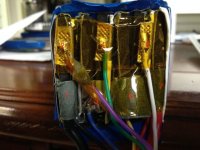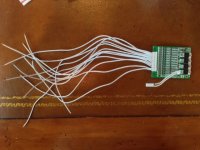majornelson
100 W
I'm creating a separate thread for this discussion.
dnmun recently sent me a Bestekpower D122 12S BMS for my 12S 44v 5AH Lipo setup (two 6s Zippy batteries). It looks great- relatively small and will make my battery both safer and more convenient to use and charge.
However, I'm looking for guidance on almost everything... I can solder.
My plan:
1) Determine which sense wire goes where on the battery and then solder.
2) Determine what goes on the 4 poles on the other end of the BMS (I assume it is charge and discharge wires).
3) Install on battery back... not certain what the "best practice" is here. The BMS is small enough to fit on the side of the battery. To date, I have wrapped two of the Zippy 5AH 6s batteries in coraplast and then duct taped them together (makes for a brick like structure). It fits neatly and tightly in my carrying case on the bike. I'd like to continue to use the existing holder.
Once everything is working, I have an on/off switch that I'll attach to the thermal fuse line (recommendation by dnmun). That way I'll be able to shut the battery off without unplugging anything.
I've reposted dnmun comments in the next post and then my follow up questions.
dnmun recently sent me a Bestekpower D122 12S BMS for my 12S 44v 5AH Lipo setup (two 6s Zippy batteries). It looks great- relatively small and will make my battery both safer and more convenient to use and charge.
However, I'm looking for guidance on almost everything... I can solder.
My plan:
1) Determine which sense wire goes where on the battery and then solder.
2) Determine what goes on the 4 poles on the other end of the BMS (I assume it is charge and discharge wires).
3) Install on battery back... not certain what the "best practice" is here. The BMS is small enough to fit on the side of the battery. To date, I have wrapped two of the Zippy 5AH 6s batteries in coraplast and then duct taped them together (makes for a brick like structure). It fits neatly and tightly in my carrying case on the bike. I'd like to continue to use the existing holder.
Once everything is working, I have an on/off switch that I'll attach to the thermal fuse line (recommendation by dnmun). That way I'll be able to shut the battery off without unplugging anything.
I've reposted dnmun comments in the next post and then my follow up questions.












